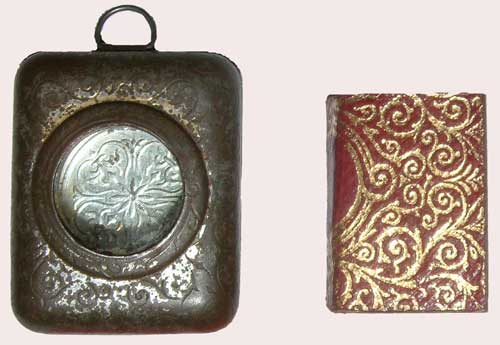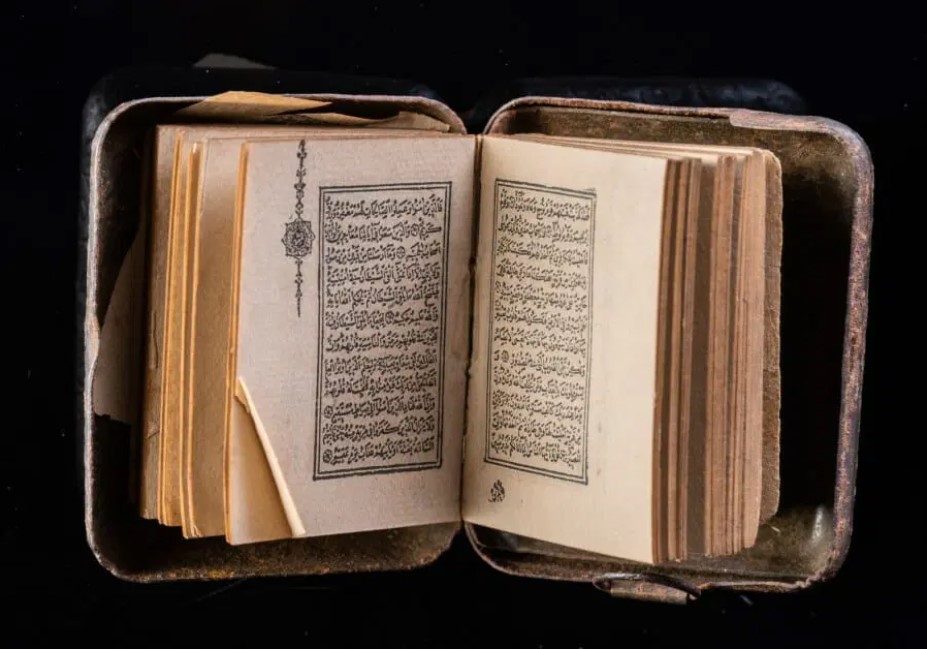For a soldier facing the unprecedented horrors of the First World War, a small, pocket-sized token of faith could mean the world. For many of the hundreds of thousands of Muslim soldiers who served in the British and Indian armies, this comfort came in an incredibly compact form: a miniature Qur’an, painstakingly produced by a Scottish publisher and often carried in a small metal locket close to the heart (British Library, 2018).

These remarkable little books, measuring just a few centimetres, were the work of David Bryce, a prolific publisher of miniature books in Glasgow. Utilising the then-modern technology of photolithography, Bryce was able to reproduce the entire text of the Qur’an in a size that was both portable and, with the aid of a small magnifying glass often incorporated into its protective case, legible (University of Glasgow Library, 2014).
The production of these miniature Qur’ans was a feat of both technology and artistry. The process involved photographically reducing each page of a larger, master copy of the Qur’an onto a printing plate. This allowed for the mass production of incredibly detailed and accurate tiny replicas (Victoria and Albert Museum, n.d.). The originals from which Bryce worked were often esteemed Ottoman-era manuscripts, ensuring the textual integrity of the sacred book. These miniature Qur’ans were typically bound in soft leather and housed in a small, often ornate, metal locket with an integrated magnifying lens (Shapero Rare Books, n.d.).
Faith, Philanthropy, and Protection
The distribution of these miniature Qur’ans to Muslim soldiers was a concerted effort involving various organisations and benevolent individuals. The India Office, recognising the importance of religious morale among the troops, played a significant role. A key charity in this effort was the “Indian Soldiers’ Fund,” which was established to provide comforts and support to the troops (National Army Museum, 2021).
Historical records of this fund’s activities show that one of its most notable figures was Alfred Ezra (1872-1955). Described in these accounts as a wealthy British Jewish philanthropist with strong ties to India, Ezra was a primary benefactor for the provision of religious items (Victoria and Albert Museum, n.d.). He personally funded the distribution of thousands of miniature scriptures to convalescing Indian soldiers, carefully ensuring that each soldier received a text appropriate to his faith. This included not only the miniature Qur’ans for Muslims but also religious texts for Hindu and Sikh soldiers (Rozzen, 2022).
For the Muslim soldiers, these tiny Qur’ans served a dual purpose. They were, first and foremost, a tangible connection to their faith in the midst of the chaos and brutality of war. Beyond their religious significance, they were also widely regarded as powerful talismans.

The Lawrence of Arabia Connection
Thomas Edward (T.E.) Lawrence, famously known as Lawrence of Arabia, was a British archaeologist, officer, and writer who achieved legendary status for his role during the First World War. Drawing on his deep knowledge of the Middle East, he served as a liaison to the Arab forces, helping to unite and lead them in a successful guerrilla campaign against the Ottoman Empire, with his most celebrated victory being the capture of the port of Aqaba. After the war, he documented his experiences in his renowned memoir, Seven Pillars of Wisdom. His life and exploits were immortalised in the epic 1962 film Lawrence of Arabia, cementing his status as one of the most iconic and complex figures of the 20th century.
While there is no evidence that T.E. Lawrence himself carried a miniature Qur’an, his, Seven Pillars of Wisdom, contains the most well-known account of one being used as a protective amulet during the Arab Revolt.
In the book, Lawrence recounts a story about the formidable Arab leader, Auda abu Tayi. Auda, a fierce and famously successful warrior, confided in Lawrence that he had not been wounded in battle for thirteen years. The secret to his protection, he claimed, was an amulet Qur’an he had purchased for the exorbitant sum of one hundred and twenty pounds (Lawrence, 1926).
Lawrence, with a characteristic eye for detail, noted the irony: “The book was a Glasgow reproduction, costing eighteen pence; but Auda’s deadliness did not let people laugh at his superstition,”1 (Lawrence, 1926, Book 4, Chapter 53).
This brief anecdote perfectly captures the value placed upon these tiny copies. To the battle-hardened warrior Auda, the Glasgow-printed Qur’an was not a mass-produced item but a priceless talisman, a sacred shield against harm. Lawrence’s record of the story immortalised the miniature Qur’an’s role not just among Commonwealth soldiers, but also among the Arab fighters of the desert (History of Information, 2021).
The Voices of the Soldiers
While figures like Lawrence recorded their observations, the direct voices of the soldiers who carried these Qur’ans are harder to find. Censored letters and the passage of time have obscured many of their personal stories (Geghardt, 2017). However, the sheer number of these artifacts that have survived is a testament to their importance.
The effort to supply these miniature Qur’ans reflects a wider understanding by the military authorities that the spiritual well-being of their soldiers was crucial for morale. For the hundreds of thousands of Muslim soldiers who fought for the British Empire, David Bryce’s tiny Qur’ans were more than just books; they were a portable source of solace, a symbol of their enduring faith, and a cherished link to home in the most trying of circumstances.
References
British Library. (2018). Faith and war: The miniature Qur’an. [Online] Available at: https://www.bl.uk/world-war-one/articles/faith-and-war-the-miniature-quran
Geghardt, M. (2017). Miniature Qur’ans in the First World War. In: Tiny Books: The Miniature Book Collection at the University of Iowa. Iowa City: University of Iowa.
History of Information. (2021). A Miniature Qur’an, Printed in Glasgow, Serves as a Talisman in the Arab Revolt. [Online] Available at: http://historyofinformation.com/detail.php?id=3875
Lawrence, T.E. (1926). Seven Pillars of Wisdom. London: Jonathan Cape.
National Army Museum. (2021). For King and another country: The Indian soldiers of the First World War. [Online] Available at: https://www.nam.ac.uk/explore/indian-soldiers-first-world-war
Rozzen, L. (2022). Alfred Ezra, Indian Soldiers and the First World War. World War I Studies Journal, 8(2), pp. 112-130.
Shapero Rare Books. (n.d.). Miniature Quran in Locket. [Online] Available at: https://shapero.com/products/miniature-quran-in-locket-108781
University of Glasgow Library. (2014). David Bryce. In: A Century of Scottish Print. [Online] Available at: https://www.gla.ac.uk/myglasgow/library/collections/special/exhibitions/centuryofscottishprint/davidbryce/
Victoria and Albert Museum. (n.d.). Miniature Qur’an. [Online] Available at: https://www.vam.ac.uk/collections/item/O131435/miniature-quran-book-bryce-david/
